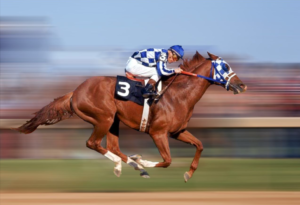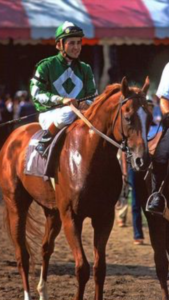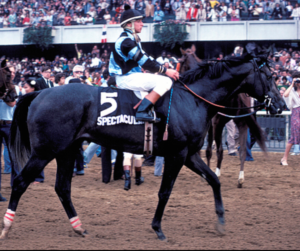
By: William G. Gotimer, Jr.
It was the fall of 1978, the world was in its usual state of flux, New York City was in the midst of its financial crisis, and something called a cellular phone was being used for the first time. The world also saw a test tube baby for the first time and a portable stereo called the “Walkman” was making music portable. The Catholic Church had three Popes in the span of seventy days and a phantom named the Uni-bomber was beginning his terror spree. It was a time of uncertainty and fear but also great promise. The only thing for certain was that things were changing – all the time.
For those of us in the horse racing world, things were proceeding as usual and we were confident we had it figured out, and knew exactly what was coming. Everything had gone so smoothly since Secretariat came onto the scene. Secretariat was so brilliant as a two year old that he even eclipsed his older stablemate Riva Ridge, who was in his own right very good.

Secretariat was so good as a two year old that he was named Horse of the Year – an honor that no two year old could even aspire to – let alone attain. He roared into his three year old campaign, and even with a bump in the road when he lost the Wood Memorial due to a sore tooth, he swept the Triple Crown with such authority it left young people breathless and grizzled old horse players in tears. Such was his power and dominance that even two more losses later in the year did not diminish his greatness.
The first Triple Crown winner in twenty five years accomplished the feat so powerfully that no one dared question his worthiness. Fans grudgingly accepted his early relocation to the breeding shed because his connections were diligent in assuring he touched all the bases of greatness. He was the best of his generation, won at sprints and routes, beat older horses, won giving weight, won on dirt and grass and in a sporting gesture and a nod to the Canadian roots of his trainer and rider, won in Canada. He set track records along the way and managed to be on the cover of news stalwarts – Time Magazine and Newsweek in the same week.
Secretariat’s departure to stud left a big hole in the sport, but it was clear that his babies would come along soon enough, if we could only make due until that day arrived. We had no way of knowing how lucky we would be during that waiting period.
Forego, who ran in Secretariat’s Kentucky Derby before fully growing into his huge frame, as well as being gelded, would emerge as the best handicap horse in a generation; the fabulous and fantastic, rough and tumble filly Ruffian would come along and thrill us like no other, before her tragic ending in the ill-conceived match race with Foolish Pleasure. The fierce and fleet footed Seattle Slew would come along for unknown connections and dominate the Triple Crown again in 1977, with front running victories where he looked like a dark streak as he rolled off one fast quarter after another.
If that wasn’t enough, 1977 saw the beginning of a rivalry between two year olds from different backgrounds. The royally-bred Alydar from Kentucky and the modestly bred Affirmed from Florida would trade victories as two year olds and come into the 1978 Triple Crown races as rivals – each with their own fierce supporters.
Despite every effort by a dead game Alydar and his rider Jorge Velasquez they never could manage to get by Affirmed and his teenage rider Steve Cauthen, and we were again treated to a Triple Crown winner – this time one where tenacity and grit – not power and brilliance – was the notable characteristic. The fact that they met again in the Travers even with its unsatisfying result by the disqualification of Affirmed was simply icing on the cake.
We understood this game now. We knew now how to look for the next great one. We were puzzled when the first crop sired by Secretariat was less than stellar, but we were confident the next great one was right around the corner. When we turned our eyes towards the two year olds of 1978 we knew what we were looking for and there he was. He was a son of Secretariat owned by Bertram Firestone; trained by Leroy Jolley, who trained stakes winners by the dozen, and he was beautiful. It was exactly a week after the Travers where Affirmed beat Alydar again, but lost the race in the stewards’ stand.

It was the Hopeful Stakes, the last stakes of the then four week Saratoga meet and General Assembly, the son of Secretariat was about to take his rightful place as the heir apparent. He didn’t disappoint. Not only did he run like his father, he looked like him. He rolled to an authoritative victory and we all nodded that we had seen the two year old champion and 1979 classic winner. Remember – we had this game figured out.
Fast forward eight weeks to Belmont, October 8th, 1978. Here is where I enter the picture. General Assembly was favored to annex the Champagne Stakes on his inevitable march to the two year old Eclipse Award and I was assigned to work selling tickets on the third floor of the Belmont Clubhouse. The high rollers and larger bettors frequently gathered on the third floor of the Clubhouse at Belmont back then. I was proud to handle the larger bets.
It was before the new era of computerized mutuals, and racing was slowly moving away from the requirement that each race only be bet in the thirty or so minutes before the race. Advanced wagering, as it was called, was being approached cautiously due to tradition, computer limitations and union rules. At that time advanced wagering on the remainder of the card could only take place after the Daily Double (note the word Daily – as there was only one per day and it was on the first two races).
Before the first race ,I was approached by an unassuming man in his forties (maybe since I was 19 everyone looked old) and he asked when he could bet “the feature”. I politely told him he had to wait until after the Daily Double. After the first race ,he reappeared and asked again. I indicated that it wasn’t after the Daily Double had been closed to wagering but after the races had been run. He apologized and dutifully returned after the second race to inquire a third time. This time I had to tell him he had to wait until the second race was official. He stepped away again.

Finally the bell rang signifying that the third race and all subsequent races were now open for betting. I motioned to the patient gambler and he approached. He indicated he wanted to bet the feature. This was an understatement. He produced four banded stacks of $100 bills each containing $5,000. He wanted to bet $20,000 all to win.
Knowing what I knew, knowing that I had figured this game out, here was a man I wanted to emulate. He, like I, knew that General Assembly was the heir apparent, the Secretariat progeny we were all waiting for. He, like I, knew it was just a matter of putting down the money, waiting for the race to be run and then picking up the money again with a 70-80% profit. I placed my hand on the number three button correlating to General Assembly. He corrected me. “Number 2 please” he commanded. “What!” I thought. “Are you sure” I said as I flipped my program to see who he was betting. “Yes sir” he said “Spectacular Bid. You might want to bet him yourself.” I was flabbergasted. I punched out 400 $50 Win tickets on Spectacular Bid – my mind puzzled and somewhat numb. Was he mad or informed? Was he eccentric or slick? Was he too rich for his own good?
Within hours people would know. When the betting for the feature opened up there was a buzz as Spectacular Bid – not General Assembly – was the favorite. Eventually the New York betting public ignored the early money and showed its loyalty to General Assembly, making him the favorite at $1.40-1. Despite the early money Spectacular Bid fell to the $2.40-1 third choice after Calumet Farm’s Tim the Tiger became the second choice at $1.70-1 in the last minute.
When the gates opened we knew. What we knew was that you never know what is around the corner. Within jumps of the start Spectacular Bid had assumed the lead from his rail post position and the chase was on. General Assembly would gamely try to get to the leader on the turn, but the gray colt would skip away from the son of Secretariat and snatch the title of the next great one, and hold onto it through his retirement after his four year old season. He would be forever known as one of the best horses not to win the Triple Crown and he would have the honor of winning the 1980 Woodward in a walkover when no one could be convinced to try and run against him.
General Assembly had his share of glory too, running admirably in the 1979 Triple Crown, and winning the Travers in the slop by open lengths, but it would be The Bid who would be the next great one.
In addition to vividly remembering Spectacular Bid’s New York debut, a few things have always stayed with me from that day. First and foremost, this is a great game. Less abstractly my take away was this in ascending order of importance; never ignore early money; respect the horsemen and women of Maryland, and most importantly –“you never know who is around the corner. As in racing as in life the strongest opponent you may face is the one you don’t see coming – you simply never have everything figured out.”



